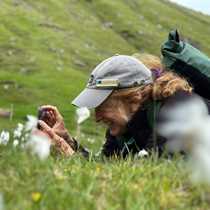Santa Rosalia, San Ignacio, San Ignacio Lagoon
Have the photographs enticed you to read these few paragraphs? The best part is, I know the whole story, right now, and how the day started, flowed, and ended. Now the fun part is to tease and tantalize you with tidbits of our grand adventure.
The sheltered port of Santa Rosalia welcomed the National Geographic Sea Bird with starry skies reflected in the harbor’s calm waters. We greeted sunrise on the road, headed for the town of San Ignacio. The day’s first rays lit the Tres Virgenes volcanoes into parfait hues of peach, mango and blood orange. An hour later, in the town of San Ignacio, a few dedicated roosters called to any resident sleepyheads still in bed to greet the day. The local water truck urged them further as it honked its presence while circumnavigating the main plaza. We munched on locally baked date bread and washed it down with strong coffee and fresh squeezed orange juice. Back on the road, the last leg to our destination of San Ignacio lagoon, we encountered a surprise, an extra 10 kilometers of paved road over last year!
Upon arrival at our respective camps we were oriented by our hosts, settled into our bungalows and feasted on fish tacos before heading out in pangas to the lagoon. The tide was going out, so we waded a few yards out to the pangas, climbed in, and started off toward the official whale watching areas. Conditions in the lagoon were unbelievable: clear sunny skies, balmy temperatures and barely a breath of a breeze. Best of all, there were whales, whales all around us: grey whale cows and their dimple-skinned newly born calves. There were a few single adult whales as well, perhaps pregnant females soon to give birth in the protection of San Ignacio Lagoon. We saw two cow-calf pairs right as we approached the viewing area. An adult whale spy hopped over by another boat; flukes flipped skyward as yet another whale dove; a dark grey little baby whale rolled off the back of its mother.
Baby grey whales, bobbing their heads suddenly above water, puff, an exhale, poof, an inhale and down again. They were quite the opposite in efficiency of motion compared to the rhythm of their mother’s breaths. In years past, our experience has been a practiced caution by the mother whales in the early weeks after the birth of the calf; fortunately, these whales had not checked their notes from previous years, and several of our boats had whales approach, and allow the gentlest touch by human hands. Carlos Varela the manager of the Kuyima camp was in one of our pangas, he asked what did the whale feel like on your hand, the description given was somewhat soft and squishy. Then he asked, how does it feel in your heart? The answer was a grin from ear to ear: indescribable.
Returning to the camp, the tide had fallen, a signal for the birds of the lagoon to come and partake in a feast. Reddish egrets, marbled godwits, white ibis and scores of Brant geese all worked the mudflats and shallows. Coyotes took the clue of the ebb tide as well and nearly a dozen were sighted searching the shoreline for anything edible that may have stranded. Bottlenose dolphins, bow riding on the pangas, escorted us back to our camps.
Reflecting on our experiences with the whales, some of us walked the beach upon our return. We found the skeleton of a grey whale, bleached out and arranged on the sand as life originally articulated the animal. Next to the whalebones were skulls of sea lions, dolphins, sea turtles and a small dried sea horse. A chorus of coyotes calling in wavering yips announced sunset. We gathered for dinner to share stories of our afternoon encounters. Tucked into our bungalows with dreams of grey whales spy hopping in our heads we looked forward to tomorrow, and another perhaps indescribable experience in San Ignacio Lagoon.



